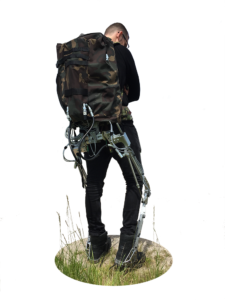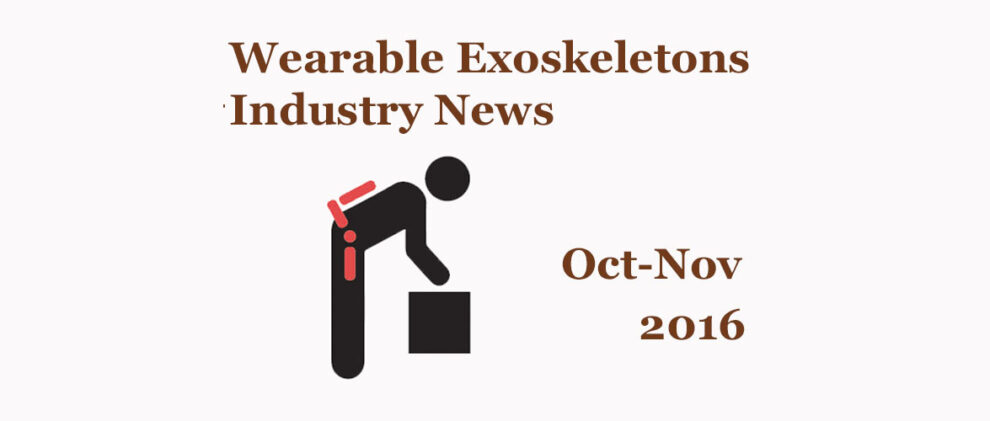SuitX finally releases more information on the MAX, Brokerage and Pitching Event, a new events calendar, yet another misreported study and a robotics talk that hits close to home and InteSpring releases their own military exoskeleton. This is a broad sample of what’s happening in the exoskeleton industry between October and November 2016.
MAX
SuitX (formally US Bionics) have updated their website. It now features significant details on their multi-year effort to build a modular exoskeleton for work & industry. The MAX is composed of three modular components: backX, shoulderX and legX.
The backX most closely resembles the Laevo v1. This exoskeleton is physically able to bypass some of the loads away from the spine while bending forwards to lift or pick up an object.
The shoulderX is similar to the Ekso Works Vest. Rather than having a full tool holding exoskeleton, only the arms are supported between the shoulder and the elbow. This allows the user to perform tasks above the waistline, especially overhead tasks, for a significantly longer duration without getting fatigued. Task examples from the SuitX shoulderX website are paneling, electrical work, welding, grinding, picking, pruning, painting, inspecting, and drilling.
Finally, the legX is a passive exoskeleton for the knees. It allows the wearer to squat for prolonged amounts of time. Furthermore, the legX features a “lock” feature that can turn it into a chairless-chair type of device.
For much more, visit the newly updated SuitX website.
Exoskeleton Technology Brokerage and Pitching Event
Six European collaborative projects present Exoskeleton Technology Brokerage and Pitching Event 28 November 2016, 11:30-17:00 Amsterdam, the Netherlands. This exciting event will be equivalent of a one-day mini-convention that will feature at least six exoskeleton projects: AXO-SUIT, BALANCE, MovAiD, Robo-Mate, SPEXOR, Symbitron. Additional presenter and attendee space is limited.
Links: Brochure, Program, Website
What is really striking about the Brokerage and Pitching Event is that it is effectively a half day to a day mini convention primarily based on geographical proximity. If it is a success and people find it useful, there is the potential for mini exoskeleton conventions sprouting every place where there is a concentration of exoskeleton users and companies such as Japan, Korea, San Francisco Bay Area and North East US (see Map of Exoskeleton Companies).
ExR finally has an Exoskeleton Events Calendar
On the subject of industry events, the Exoskeleton Report finally has an events calendar! It can be found here and there is also a link to it on the top menu bar.
One major event to watch out for will be the upcoming Wearable Robotics Association Conference 2017 which will take place April 19th – 21st 2017 in Phoenix, Arizona.
Monkey’s regaining partial voluntary muscle control and the monkey business of reporting on it
A study published in Nature demonstrated progress on brain-machine devices. In this study, a monkey that had suffered partial spinal cord injury that would heal over time by itself was equipped with an implant to stimulate the nervous system based on brain readouts. The monkey was able to recover leg function to the point of full ambulation. The technology is decades away from human trials and is incapable of dealing with full spinal cord injury at this phase of research.
The US media took the story and ran with it and with each iteration made it more sensational. At the end, facts were so exaggerated that popular news sites made it sound like the end of paralysis and physical rehabilitation are right around the corner. Such over exaggeration of similar technologies causes a significant suppression in the interest in medical exoskeletons. Why waste money on researching wearable robotics when spinal cord implants are almost here (answer: because they are not)!?
The challenges of the entire robotics industry resemble those of the exoskeleton industry all too well.
Silicon Valley Robotics Andra Keay in an interview with Techworld did not mention wearable robotics or exoskeletons once, yet some of the challenges she sees in robotics translate perfectly well. Andra Keay has the following observations:
- Many robotics engineers have no other real-world experience. She sees robotics as being a too “demographically homogeneous discipline.” This has been a major challenge to the exoskeleton industry which requires a wide array of expertise (biology, medicine, sewing, engineering, ergonomics, etc.)
- “Robotics is not so much a technical as a business problem. There’s a lot of good tech but it’s underutilized and under-required. So we’re focusing on making better connections between entrepreneurs and robotics teams.” In the exoskeleton industry, this is further amplified as exo companies have to talk to medical centers, regulators, insurance companies, etc…
- There is an ethical responsibility to introduce robotics where people are in harm’s way. Keay might be thinking of removing humans, bust exoskeletons that are specialized for safety can make many professions safer.
- An aging population wants help to stay longer in the workforce.
- “I see a lot of companies trying to overhype and oversell. They’re going to disappoint us and I hope it doesn’t bounce back on the industry…”
Keay’s interview (posted on techworld.com) is somehow reassuring that the challenges wearable robotics and exoskeletons are facing are not unique.
Exobuddy military exoskeleton

InteSpring, the supplier of the proprietary gas springs used for the Laevo have released pictures of a secret military project for the Dutch army: a semi-passive load-bearing exoskeleton ExoBuddy. This is taken directly from the company’s website:
In the past three years has InteSpring in cooperation with TNO worked secretly to a special exoskeleton for the Dutch Defense. The exoskeleton will be used as support troops for a march or tactical move. The backpack they bear is 40kg, but with the exo feels “only” as 15kg. Although the exoskeleton is still deep in the development phase, the current version of the Exobuddy is already so good that soldiers say they want to wear it in the field. The uniqueness of this exoskeleton is that it not only supports a great weight but is additionally “passive” and therefore lightweight.








Add Comment